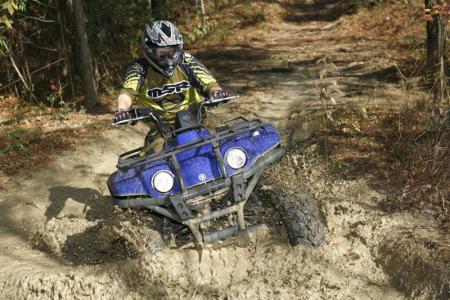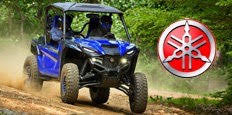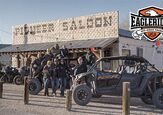2009 Yamaha Big Bear 400 IRS 4×4 Review
Finding a demographic for an ATV is just the first step to having great success for a manufacturer. Yamaha decided to look at the southeastern United States to find the perfect suitor for its Big Bear 400.
In 2007 the Big Bear 400 was introduced as a solid machine for working class users, but it has advantages for more adventurous riders as well. Digging into the southern states Yamaha revealed some startling numbers about its potential buyers. The United States has several unique areas that make up the vast majority of this Big Bear’s market. The 5-speed air-cooled 4×4 ATV makes up 25 percent of the total sales of 4×4 ATVs with 50% of those sales in states along the southeastern U.S. This is where swamps and low-lying creek flooded farmland will make the Big Bear shine. Yamaha’s Newnan, Ga. facility is in the heart of this prime workhorse ATV’s element. With all of the numbers in mind let’s look at what makes the Big Bear 400 a success.
The Big Bear 400 is at home in the mud and muck.
The 386cc motor is air cooled for a few reasons. If you were to take a liquid cooled engine into deep mud and muck, the radiator can become clogged and cause overheating. If the radiator becomes clogged it will cause high temperature issues that can finish off the average ATV. This is why Yamaha decided to go with an air-cooled. Though there is the oil cooler to deal with on an air cooled engine, it has been relocated to get it up behind the protection of the front fenders in the nose of the Big Bear. The oil cooler’s capacity has also been increased by 30 percent which not only provides the reserve oil needed to keep the motor running clean but it also makes for lower engine temperatures and better performance. Everything vital to the quad is protected.
Marine-style connectors keep the electrical components dry.
The engine of the Big Bear 400 draws air through a 33mm Mikuni carburetor. Having an EFI or electronic fuel injection throttle body would have been easy, but to keep with the plan of the simple serviceable unit Yamaha opted for the traditional carburetor. This allows the rider to maintain things himself, even on the trail. If you get water in your fuel, and sometimes it happens, you just drain the carb bowl with a simple turn of the screw on the bottom of the carb and get back to riding. Remember this – the Big Bear is simple and we found that out with every feature.
The Big Bear’s 386cc engine is fired by a standard DC-CDI ignition system. The 8.6:1 compression should allow for easy starts and smoother running. Not to mention it adds reliability to the life of the Big Bear.
The electrical components on the Big Bear have been upgraded to Marine-style connectors. These plugs and wiring systems can be submerged in water and still remain dry where it counts. This is a feature that all utility ATVs should be built with from the factory. If it’s built to get wet and dirty then it has to be safe and that’s where Yamahas engineers didn’t pass the buck.
The electric start, which is just a touch of the button located on the left handlebar mounted control center, will fire the Yamaha Big Bear to life. But let’s say you happen to drain the battery and need an alternate. Then you can pull till your heart’s content on the rope style pull start located on the lower left side of the engine just about at your ankle. I prefer the electric start myself, but just for the experience we had to try the pull start just once. It was an easy pull and it fired right up the first time. That’s a great feature and it should make hunters happy all over the Southeast. It does get cold down in the south and although the maker of the battery wants it to perform in any condition it will run down or just be plain lazy sometimes in colder weather.
Once the engine is fired up you have five gears and a reverse. The transmission has an automatic clutch, which allows you to stay focused on the trail and hold onto the Big Bear. This not only eliminates costly maintenance of the clutch system, which in the mud can be a regular task, it also makes the operation just a bit easier.
Yamaha included engine braking on the Big Bear, which is a feature other manufacturers charge extra for. Yamaha provides this feature for your safety. Other braking options include dual hydraulic disc brakes in the front, while and on the rear you have a new feature in the sealed oil bathed five-disc braking system.
Yamaha has put its ‘On-Command’ push button three-way locking differential on the right side of the bars. The button is unique in that it has a few different operations. Pressing the 4×4 button in allows a limited slip feature. This seems to be all the Yamaha Big Bear needs in the deep stuff, but there is fully locked differential selection as well. This feature makes the Big Bear unstoppable in most any condition. All of the Big Bear’s power is transferred to the wheels by drive shafts and they all have protective boots to keep the trash out.
A whopping 10.5 inches of ground clearance keeps the Big Bear clear of on-trail obstacles.
ITP’s MudLite tires were made specifically for the Big Bear.
Keeping you stable and comfortable on the trails is independent double wishbone front and rear suspension. This Bear has 10.5 inches of maximized ground clearance, so deep ruts pose no threat. The shocks that suspend this Bear are five-way preload adjustable and can also be adjusted on the trail for the discriminating rider. The Big Bear seemed easy to handle and there is little feedback in the steering when encountering roots and rougher terrain.
Front tires on the Big Bear measure 25×8-12 and the rears are 25×10-12. This helps with the ground clearance as well. It seems that Yamaha wants to give you everything you need and make sure that when you leave the dealer floor you are ready for anything. ITP developed the MudLite for the trail user who likes getting into mud and creeks without getting stuck. They also made the MudLite to be gentle on your body over rough terrain at low speeds by softening out the side-wall of the tires. The end result is a tire that’s comfortable for any rider and can get over most any obstacle.
The Big Bear 400 has many features from the simple speedo to the intergrated floor boards to keep the mud off of your boots. Of course this only works if you don’t get into the deep stuff. The colors for the 2009 Big Bear are Hunter Green, Steele Blue and Black Mettallic. There is also a Realtree AP HD Camouflage version for the hunter in your life. Dual 30watt Krypton Multi-reflector headlights also come standard for those trips to the deer stand. The improvements over earlier models are totally noticeable and will make the Big Bear a stand out competitor in the woods and mud.
Ride Impressions
Our ride time was a blast on the Big Bear 400. The simplicity of operation took all of the worry out of the picture. The machine truly allows you to enjoy the ride and be in control of the machine. A steering damper would help helpful to take the twitch out, but it wasn’t an overwhelming issue on our ride. Getting down into the deep stuff we found that the Big Bear really is a torque monster. First gear had probably the lowest ratio I had seen in my days of riding. This could be problematic at times and I felt second gear was a better starting place in most situations. Firing up the 386cc engine was never a problem and from a mechanic’s point of view the starting system looks really easy to maintain.
Yamaha’s sealed rear disc braking system really helps this ATV stand out.
One thing that stuck out in my mind was the sealed rear disc braking system that Yamaha has designed for the Big Bear. The braking components are sealed in an impermeable case with the rear tranny gears. This was most evident when I would go through deep mud and then try to stop the Big Bear. I never had trouble like I remember having with the open air style braking systems. Yamaha even claims with regular servicing of the gear fluid the brakes should last the life of the ATV.
Overall the redesigned Yamaha Big Bear that was introduced in 2007 is a great machine and definitely a purpose built machine. It rides comfortably and will have a place in every garage for years to come.
| 2009 Yamaha Big Bear 400 IRS 4×4 Specs | |
| Engine Type: | 4-Stroke Single, Air/Oil Cooler w/ Fan, SOHC |
| Bore x Stroke: | 83mm x 71.5mm |
| Compression Ratio: | 8.6:1 |
| Carburation: | Mikuni 33mm BSR |
| Ignition: | DC – CDI |
| Starting System: | Electric w/ Auxiliary Pull |
| Transmission: | 5-Speed Automatic Clutch w/ Reverse |
| Drive Train: | Yamaha On-Command push button 3-way locking differential, 2WD, 4WD, locked 4WD; Shaft |
| Front Suspension: | Independent Double Wishbone, 5.8” w/ 5-way Preload Adjustment. |
| Rear Suspension: | Independent Double Wishbone, 7.6” w/ 5-way Preload Adjustment |
| Front Brakes: | Dual Hydraulic Disc |
| Rear Brake: | Fully Sealed, Oil Bath, Multi Disc |
| Front Tires: | ITP Mud Lite 25×8-12 |
| Rear Tires: | ITP Mud Lite 25×10-12 |
| Length/Width/Height: | 79.4” x 43.9” x 46.7” |
| Seat Height: | 35.2 in |
| Wheelbase: | 48.4 in |
| Turing Radius: | 126 in |
| Ground Clearance: | 10.5 in |
| Fuel Capacity: | 4.0 gal |
| Dry Weight: | 593 lb |
| Rack Capacity: | 88 lb Front / 176 lb Rear |
| Towing Capacity: | 904 lb |
| Instrumentation: | Speedometer / Odometer & Fuel Gauge |
| Lighting: | Dual 30W Krypton Multi-reflector Headlights & 21/5W Brake light |
| MSRP: | $5,799 ($6,149 for RealTree AP HD Camo) |
Related Reading
Whether he is in Mexico covering the Baja 1000, building ATVs for local racers, or out enjoying the trails, Rick’s passion shows in his stories. Learning to wrench his own machines from his grandfather, Rick also has an undying appreciation for the mechanics of off-road vehicles. Do not let the dirt and mud fool you, though, as Rick also has a deep love for street cars.
More by Rick Sosebee

































